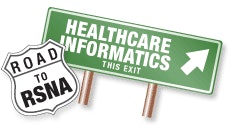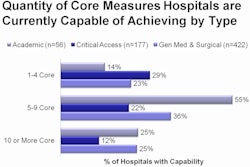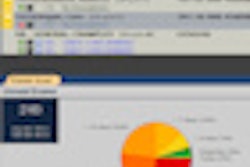At RSNA 2009, the subject of healthcare informatics maintained a surprisingly low profile. This certainly isn't the case at RSNA 2010.
Attendees at this year's annual meeting could dedicate 100% of their time attending a plethora of scientific sessions, poster presentations, and interactive poster demonstrations, refresher courses, and imaging informatics workshops. Not to mention visiting the RSNA Quantitative Reading Room of the Future at the Lakeside Learning Center.
And we aren't even talking PACS!

At this year's conference, key topics include:
- Methods and systems to extract, measure, and incorporate radiation dose exposure from CT and other modality examinations
- Data mining of radiology reports and medical records for every conceivable application.
- Structured reporting templates and savvy ways to use them
- Reporting of urgent and critical results and unexpected findings
- Electronic auditing to improve quality assurance, patient safety, and accuracy of billing
- Decision support software for clinicians ordering exams
Decision support software versus radiology benefits management: Which will it be? If this is of interest, don't miss the Sunday morning scientific session dedicated to the topic of clinical decision support (November 28, 10:45 a.m.-12:15 p.m., SSA11, Room S403A). There's also a refresher course dedicated to this subject (Tuesday, November 30, 8:30 a.m.-10:00 a.m., RC326, Room S403B).
If you're a member of a U.S. radiology practice group, don't overlook "Adding Millions of Dollars to Your Practice Through Meaningful Use" (Monday, November 29, 3:30 p.m.-4:30 p.m., IX21, Room S402AB). This course explains how to qualify to receive stimulus funding for going digital. Radiology IT vendors should enroll in course IX11, entitled "What Your Customers Will Demand and Your Competition Will Provide" (Sunday, November 28, 2:30 p.m.-3:30 p.m., Room S103AB).
Last year, the rollout at RSNA of a free library of 70 best practice report templates stole the show based on the international level of interest the RSNA received about them during 2010. This year, 30 new templates will make their debut, as well as a preview of a new searchable website that will house them. Don't miss course II31, the RSNA Reporting Initiative (Tuesday, November 30, 10:30 a.m.-12:00 p.m., Room S501ABC).
If you or your colleagues have difficulty understanding the inner workings of your IT department, a refresher course entitled "IT Management for Radiologists" is tailor-made for you (Monday, November 29, 8:30 a.m.-10:00 a.m., RC230, Room S504AB).
The Qualitative Imaging Reading Room of the Future at the Lakeside Learning Center is well worth a visit. It will feature 23 interactive educational demonstrations that showcase products in development or that have been newly introduced for commercial sale.
The reading room will showcase how qualitative analysis can be integrated into the imaging workflow. Qualitative imaging is the acquisition, extraction, and characterization of relevant quantifiable features from medical images for use in research and patient care. See what the future holds. At the pace that healthcare informatics is moving, these innovations will arrive sooner than you think.
Below you will find a selection of scientific and poster presentations that you might want to consider attending. But we couldn't include them all, so make sure to visit the RSNA 2010 meeting program website if you haven't done so already to see the impressive selection of options relating to healthcare informatics.



















